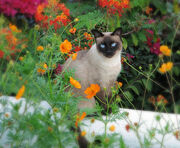
Description
[edit] AppearanceEdit[]
[2][3]Traditional Siamese CatThe Thai or traditional Siamese shares some features with the Modern Siamese (e.g., the colour pattern and the short single coat, although not so short and "painted on" as the modern) but differs from it in head and body type. It has a "foreign" type (rather elongated, high on the legs, lithe but substantial, with medium boning) not an "oriental" type as in the modern Siamese and Oriental breeds) and it has a modified wedge head, with rounded cheeks from which project a wedge shaped muzzle (or "marten face" as it was called in 19th century descriptions). The ears are moderately large and higher than those of the modern Siamese ears are. The eyes are medium to slightly large, a full almond shape but not extremely "oriental."
siemesThe pointed pattern [1] is a form of partial albinism, resulting from a mutation in tyrosinase, an enzyme involved in melanin production. The mutated enzyme is heat-sensitive; it fails to work at normal body temperatures, but becomes active in cooler areas of the skin.[9] This results in dark colouration in the coolest parts of the cat's body, including the extremities and the face, which is cooled by the passage of air through the sinuses. All Siamese kittens, although pure cream or white at birth, develop visible points in the first few months of life in colder parts of their body. By the time a kitten is four weeks old, the points should be clearly distinguishable enough to recognise which colour they are. Siamese cats tend to darken with age, and generally, adult Siamese living in warm climates have lighter coats than those in cool climates. Originally the vast majority of Siamese had seal (extremely dark brown, almost black) points, but occasionally Siamese were born with blue (a cool grey) points, genetically a dilution of seal point; chocolate (lighter brown) points, a genetic variation of seal point; or lilac (pale warm gray) points, genetically a diluted chocolate. These colours were at first considered "inferior" seal points, and were not qualified for showing or breeding. All of these shades were eventually accepted by the breed associations, and became more common through breeding programmes specifically aimed at producing these colours. Later, outcrosses with other breeds developed Siamese-mix cats with points in other cat colours and patterns including Red and Cream point, lynx (tabby) point, and tortoise-shell ("tortie") point.
In the United Kingdom, all pointed Siamese-style cats are considered part of the Siamese breed. In the United States, the major cat registry, the Cat Fanciers' Association, considers only the four original colourations as Siamese: seal point, blue point, chocolate point, and lilac point. Oriental cats with colourpoints in colours or patterns aside from these four are considered Colorpoint Shorthairs in the American cat fancy.[4][5]This Siamese cat demonstrates the once common cross-eyed trait that has largely been bred out.Many Siamese cats from Thailand had a kink in their tails but over the years, this trait has been considered a flaw and breeders have largely eradicated it, although it persists among street cats in Thailand. Many early Siamese were cross-eyed to compensate for the abnormal uncrossed wiring of the optic chiasm, which is produced by the same albino allele that produces coloured points. Like the kinked tails, the crossed eyes have been seen as a fault and due to selective breeding the trait is far less common today.
[edit] TemperamentEdit[]
[6][7]Modern Siamese kittensSiamese are usually very affectionate and intelligent cats, renowned for their social nature. Many enjoy being with people and are sometimes described as "extroverts". Often they bond strongly to a single person. Some Siamese are extremely vocal, with a loud, low-pitched voice – known as "Meezer", from which they get one of their nicknames[4] – that has been compared to the cries of a human baby, and persistent in demanding attention. These cats are typically active and playful, even as adults, and are often described as more dog-like in behavior than other cats.[10][11]
They are sometimes less active at night than most cats, possibly because their blue eyes lack a tapetum lucidum, a structure which amplifies dim light in the eyes of other cats. The mutation in the tyrosinase also results in abnormal neurological connections between the eye and the brain.[12] Unlike many other blue-eyed white cats, Siamese cats do not have reduced hearing ability.
[edit] HealthEdit[]
| [8] | This section requires expansion. |
Based on Swedish insurance data, Siamese and Siamese derived breeds have a higher rate of mortality compared to other breeds. The median lifespan of the Siamese was somewhere between 10 to 12.5 years. Survival rate at 12.5 years was 42%. Based on the Swedish statistics, the majority of deaths were caused by neoplasms, mainly mammary tumors. The Siamese also has a higher rate of morbidity. They are at higher risk of neoplastic and gastrointestinal problems but have a lower risk of feline lower urinary tract disease.[13][14] It should be noted that the Swedish insurance data only tracked cats up to 12.5 years, and it is estimated that less than 50% of pure-bred cats are insured in Sweden. In addition, the data does not differentiate between breeding cats and spayed/neutered cats, the latter group having significantly lower incidences of certain types of cancer (when spayed/neutered sufficiently early); nor does the data differentiate between indoor/outdoor and indoor-only cats (indoor-only cats have no risk of traumatic accidents in traffic, and are less likely to contract infections or viruses from other cats).[original research?]